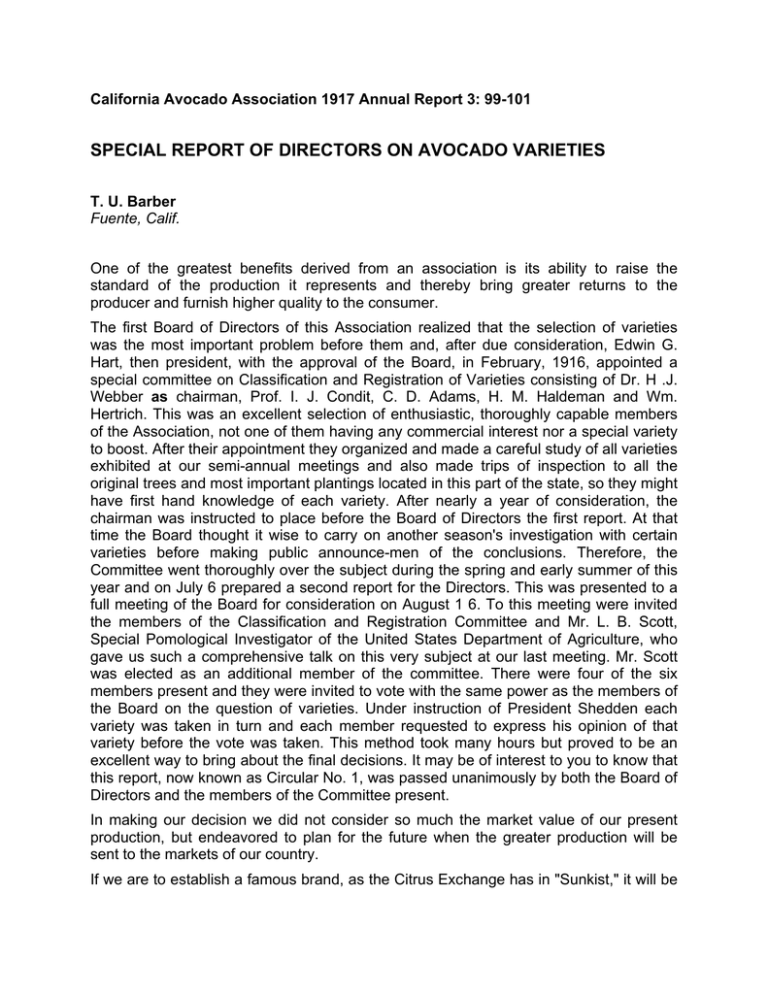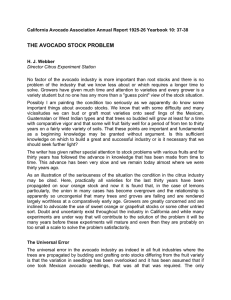SPECIAL REPORT OF DIRECTORS ON AVOCADO VARIETIES
advertisement

California Avocado Association 1917 Annual Report 3: 99-101 SPECIAL REPORT OF DIRECTORS ON AVOCADO VARIETIES T. U. Barber Fuente, Calif. One of the greatest benefits derived from an association is its ability to raise the standard of the production it represents and thereby bring greater returns to the producer and furnish higher quality to the consumer. The first Board of Directors of this Association realized that the selection of varieties was the most important problem before them and, after due consideration, Edwin G. Hart, then president, with the approval of the Board, in February, 1916, appointed a special committee on Classification and Registration of Varieties consisting of Dr. H .J. Webber as chairman, Prof. I. J. Condit, C. D. Adams, H. M. Haldeman and Wm. Hertrich. This was an excellent selection of enthusiastic, thoroughly capable members of the Association, not one of them having any commercial interest nor a special variety to boost. After their appointment they organized and made a careful study of all varieties exhibited at our semi-annual meetings and also made trips of inspection to all the original trees and most important plantings located in this part of the state, so they might have first hand knowledge of each variety. After nearly a year of consideration, the chairman was instructed to place before the Board of Directors the first report. At that time the Board thought it wise to carry on another season's investigation with certain varieties before making public announce-men of the conclusions. Therefore, the Committee went thoroughly over the subject during the spring and early summer of this year and on July 6 prepared a second report for the Directors. This was presented to a full meeting of the Board for consideration on August 1 6. To this meeting were invited the members of the Classification and Registration Committee and Mr. L. B. Scott, Special Pomological Investigator of the United States Department of Agriculture, who gave us such a comprehensive talk on this very subject at our last meeting. Mr. Scott was elected as an additional member of the committee. There were four of the six members present and they were invited to vote with the same power as the members of the Board on the question of varieties. Under instruction of President Shedden each variety was taken in turn and each member requested to express his opinion of that variety before the vote was taken. This method took many hours but proved to be an excellent way to bring about the final decisions. It may be of interest to you to know that this report, now known as Circular No. 1, was passed unanimously by both the Board of Directors and the members of the Committee present. In making our decision we did not consider so much the market value of our present production, but endeavored to plan for the future when the greater production will be sent to the markets of our country. If we are to establish a famous brand, as the Citrus Exchange has in "Sunkist," it will be necessary to have but few varieties and these of the highest quality. If our varieties increase in number in the future as they have in the past, each being allowed to enter the list unchallenged, we will have great confusion and our fruits will be classed as seedlings, such as the fruit now being shipped to New York and other eastern cities from Cuba and selling in the same markets at a very much lower figure than Trapps from Florida. California is well known for its high standard in fruit production, and we are sure this Association wishes to do its part in upholding this reputation. By co-operation we can and will furnish a continuous supply of named and branded fruits to all our markets, a product we can guarantee and of which we may be proud. With approximately 180 listed varieties, California has been absolutely without a basis from which a prospective planter seeking information could work. Many people have made a thorough canvas of the growers and nurserymen only to find that opinions were limited to the trees each was interested in propagating or had planted. The result in many cases was confusion and entire lack of confidence in the industry; many prospective growers gave up the idea of planting for this reason alone. By the acceptance of this list we have set a mark upon which all future judging will be based. To be recognized, the new fruits, which will come into bearing, will have to show superior qualities to the standards already set; therefore the standing of the Association will not be lowered by the indiscriminate propagation and sale of unknown and unworthy varieties. As an Association we are morally responsible to the many new investors joining the industry year by year. By our mere existence we invite them to invest their funds in the production of avocados, and they rightly expect our assistance. It becomes our duty to protect them from irresponsible people selling varieties which are known to be unworthy of commercial planting. The wide distribution of this circular will undoubtedly greatly reduce such unpopular business methods. The nurserymen have already taken advantage of the decision and will be able to discontinue carrying many varieties for which there has been only an occasional demand. More time and study can be spent in the selection of budwood, pruning, and the development of the trees, resulting in better grade nursery stock for the future orchards. Many people have orchards of Harman, Ganter and other thin-skinned varieties which have proven to be of little commercial value. They have been waiting for some such decided action before top-working. Even since the results have been known, several thousand trees have been re-budded and many more will be during the next year, as the information spreads to the owners of such unprofitable groves. This circular fills a long felt want, as the Association is constantly called upon for information concerning varieties, and this list furnishes official information in printed form. Many of the nurserymen have had extra copies printed for their own use and the distribution will be far reaching. It also eliminates to a great degree minor differences of opinion regarding descriptions as to weight, oil content, etc., as this information has been carefully collected from all possible sources and the average in each case printed. There were undoubtedly many of us, with plantings already started, who felt somewhat disappointed because all our selections were not recommended, but we are all sure that, after thinking the matter over in a broad-minded way, we are ready to express our sincere thanks to the Committee for the hard task they have so successfully accomplished. The Board of Directors feel they have done a wise thing and we are sure the whole avocado industry will be greatly benefited by this action in the years of marketing that are before us.


